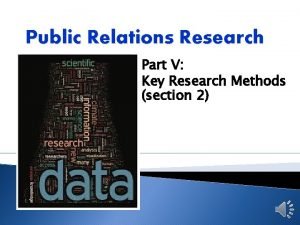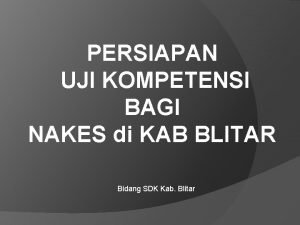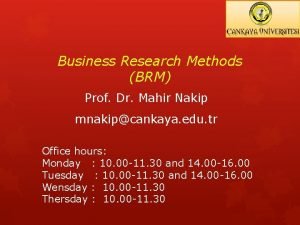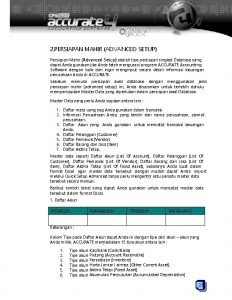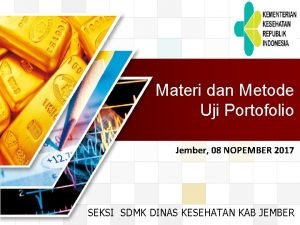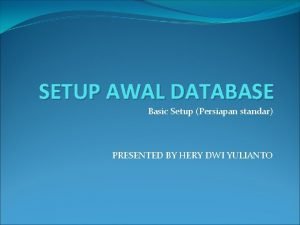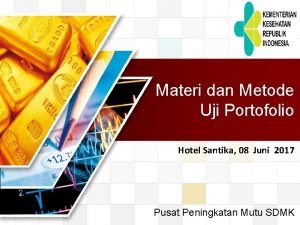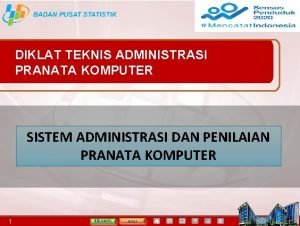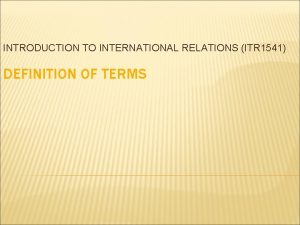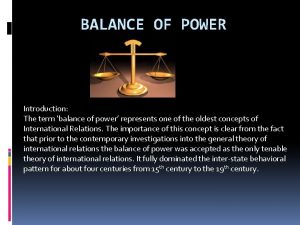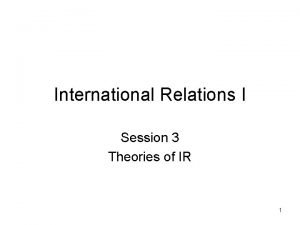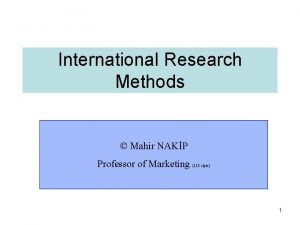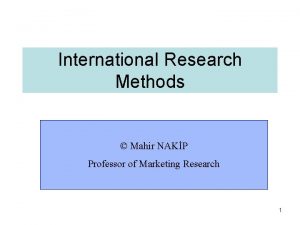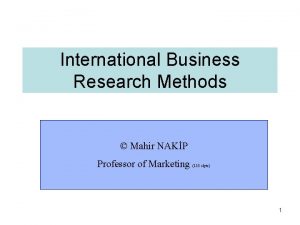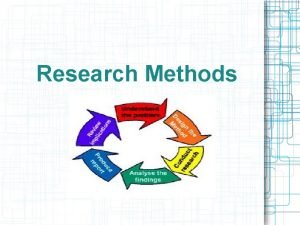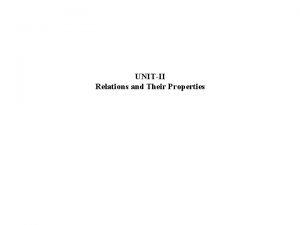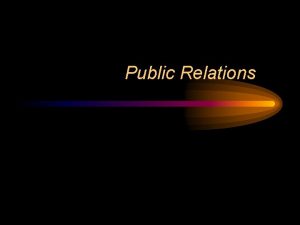Research Methods For International Relations Prof Dr Mahir



























- Slides: 27

Research Methods For International Relations Prof. Dr. Mahir Nakip mnakip@cankaya. edu. tr Office hours: Wednesday: 10. 00 -11. 30 and 13. 00 -14. 00 Thursday: 10. 00 -11. 30 and 13. 00 -14. 00

Teaching Sources 1. Main Source: Business Research Methods Zikmund, Babin, Griffin Ninth Edition, 2013


2. Main Source: Marketing Research Naresh Malhotra and Imad B. Baalbaki, 2013


3. Auxiliary Source: Pazarlama Araştırmalarına Giriş Prof. Dr. Mahir Nakip, Prof. Dr. Eyyup Yaraş Seçkin Yayın Evi Üçüncü Baskı, 2017




The main purpose of teaching this course is…. - to teach the students how to conduct a research in international field, - how many research types there are, - how to apply international methods, - what does it mean secondary and primary data, - how many stages a research process have, - how can prepare survey and observation questionnaire, - what does it mean sampling and where should be used - how hypothesis can be designed, - how SPSS package program can be used, - how many statistical methods can be used in interpreting the findings? - How to write an international relationship report?

This Course Gives What to the Students? 1. Elementary information in how to design an international research plan or proposal 2. Basic information in scientific international research sources. 3. How to reach secondary data and get benefit of it? 4. What does it mean primary data, qualitative and quantitative data 5. Preparing a questionnaire and conducting survey methods to collect original data 6. Using hypothesis testing, Chi-Square, regression, correlation and variance analysis to solve any problems. 7. Using statistical package program such as SPSS 8. Writing an international relationship scientific paper

Mid term examine Style: Classic, fill blanks, multiple choice Weight: 40% Final examine Style: Classic, fill blanks, multiple choice Weight: 40% Assignment Style: Scientific paper, solving statistical problems, short research essay Weight: 20%

1. WEEK: An Introduction to International Research Methods - The Nature of International Research - Some Basic Definitions Related to IBM - Decision-making process -International Research & Ethics -Calssifications of IRM -Research suppliers and services -International Research Process

2. WEEK: International Relationship Information and Support System - Some basic definitions - The Characteristics of Valuable Information - International Knowledge Management - International Dicision Support System - Problem definition and process - Types of variables - Proposal as a planning tool - Information Technology - Research design definition & calssification - Experiments - Theory in international research

3. WEEK: Secondary data collection - Secondary data types - Advantages & disadvantages of secondary data - Criterias for evaluating secondary data - Classification of secondary data - Computerised database - Syndicated sources of secondary data - Internal data sources - Geodemographic data - Data Warehouse

4. WEEK: Qualitative Research 1. Definition and uses of qualitative research 2. When qualitative research be used? 3. Qualitative versus Quantitative research 4. Categories of quantitative research 5. Ethnography 6. Grounded Theory 7. Philosophy and quantitative research 8. Calssification of quantitative research 9. Focus group 10. Depth interviews 11. Social networking 12. Projective techniques

5. Week: Sources of Secondary Data and Qualitative Data Analysis 1. 2. 3. 4. 5. 6. 7. 8. Sources of Internal and Proprietary Data External Data The process of qualitative data analysis Using computers in qualitative research and analysis Package programs used in qualitative researches Advantages of computer-assisted qualitative data analysis Disadvantages of computer-assisted qualitative data analysis How to Write a Research Paper? - Choosing Your Topic - Researching - Making an Outline - Writing Your Paper

6. WEEK: Primary Data and Data Collecting Techniques 1. Primary data 2. Classification of Survey Methods 3. Telephone interviews 4. Personal Face to Face 5. Traditional mail interviews 6. Internet Surveys 7. Pretesting 8. Observation

7. WEEK: Measurement and Scaling 1. Primary scales and measurement 2. Classification of measurement scales 3. Scaling techniques 4. Comparative scales 5. Non-comparative scales 6. Reliability and validity 7. Graphics and pie charts 8. Tabulation and cross tabulation

8. WEEK: Questionnaire Design 1. What should be asked? 2. Three basic objectives 3. Questionnaire design process 4. Structured questions 5. Types of fixed alternative questions 6. Choose question wording 7. Arranging the order of the questions 8. Internet questions 9. Pretesting the questionnaire

9. WEEK: Sampling 1. Meaning of the sampling 2. Differences between sampling and census 3. The sampling design process 4. Calssification of sampling techniques 5. Internet sampling 6. Sampling size determination 7. Calculating sampling size

10. WEEK: Data Inputing, Preparing, Coding, Presenting, Tabulaing and Index Numbers 1. Data inputting by using SPSS 2. Showing an examplie on SPSS with Likert scale 3. Stages of data analysis 4. Classification of statistical analysis 5. Descriptive analysis 6. How to graph the descriptive data 7. Graphics and pie chart 8. Tabulation and cross tabulation 9. Index numbers

11. WEEK: Using Univariate Statistics Analysis 1. Hypothesis Testing 2. Stages of hypothesis testing 3. Parametric tests 4. Non-parametric tests 5. Single sample 6. Two samples 7. Double sample 8. Chi Square analysis

12. WEEK: Simple linear Rregression 1. Meaning of causality 2. Types of regression 3. Simple linear regression 4. Application of regression analysis 5. Testing the validity of regression equation 6. Determination coefficient 7. Multiple regression 8. Some problems of multiple regression

13. WEEK: Correlation Analysis 1. The logic of correlation analysis 2. Types of correlation 3. Application of correlation analysis 4. Multiple correlation and its interpretation 5. Partial correlation 6. Non parametric correlation analysis 7. Using SPSS in correlation analysis


 Pr research process
Pr research process Contoh logbook perawat ahli pertama
Contoh logbook perawat ahli pertama Mahir nakip
Mahir nakip Langkah keenam pada master impor data akun adalah
Langkah keenam pada master impor data akun adalah Contoh portofolio perawat terampil
Contoh portofolio perawat terampil Perbedaan persiapan standar dan persiapan mahir
Perbedaan persiapan standar dan persiapan mahir Nilai nilai santika
Nilai nilai santika Mahir pizza
Mahir pizza Syarat pranata komputer
Syarat pranata komputer Rehberokur
Rehberokur Employee relations in public relations
Employee relations in public relations A-wax pattern recognition
A-wax pattern recognition Realist theory of international relations
Realist theory of international relations Realist theory of international relations
Realist theory of international relations Balance of power in international relations
Balance of power in international relations Examples of international relations
Examples of international relations Key theories of international relations
Key theories of international relations Constructivism international relations
Constructivism international relations Structuralism in international relations
Structuralism in international relations Realist theory of international relations
Realist theory of international relations Balance of power in international relations
Balance of power in international relations Neorealism in international relations
Neorealism in international relations Cobweb model international relations
Cobweb model international relations Cynthia weber international relations theory
Cynthia weber international relations theory Dime international relations
Dime international relations Politics and international relations bsc
Politics and international relations bsc Neorealism international relations
Neorealism international relations Constructivism theory in international relations
Constructivism theory in international relations
